This post contains affiliate links, which means I may earn a commission if you purchase through those links (at no extra cost to you).
If you love pickles and you love garlic, this pickled garlic recipe is super simple to make and keeps in the refrigerator for a few months! Not suitable for canning.
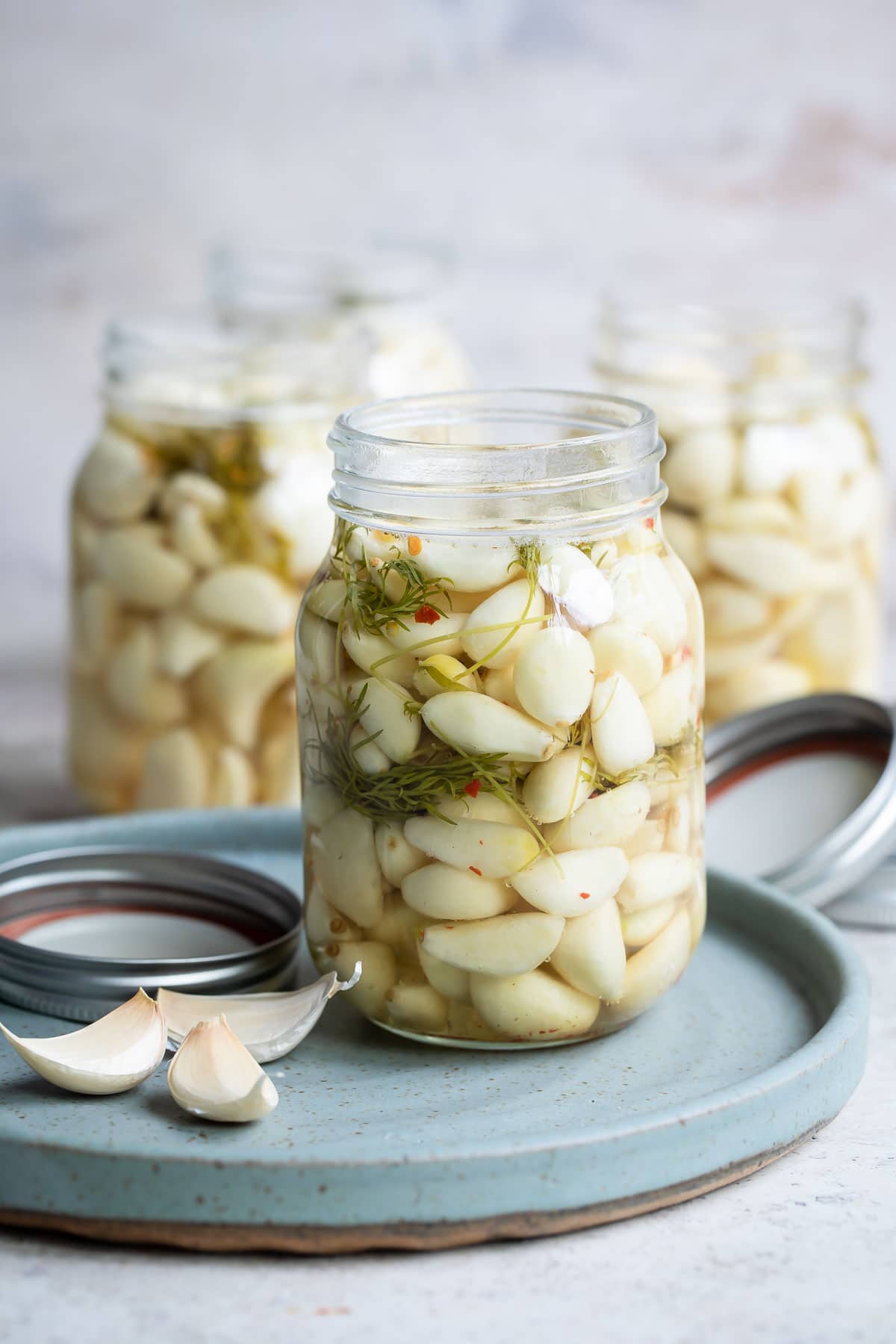
Several years ago, I was discussing Dilly Beans with my mother-in-law. She made them for a church fundraiser, and she was planning to set aside a jar for me as a Christmas gift. Would I like a clove of garlic in my jar of Dilly Beans?
My response? “Could I please have a whole jar of Dilly Garlic?” I’m so grateful she agreed!
Recipe ingredients
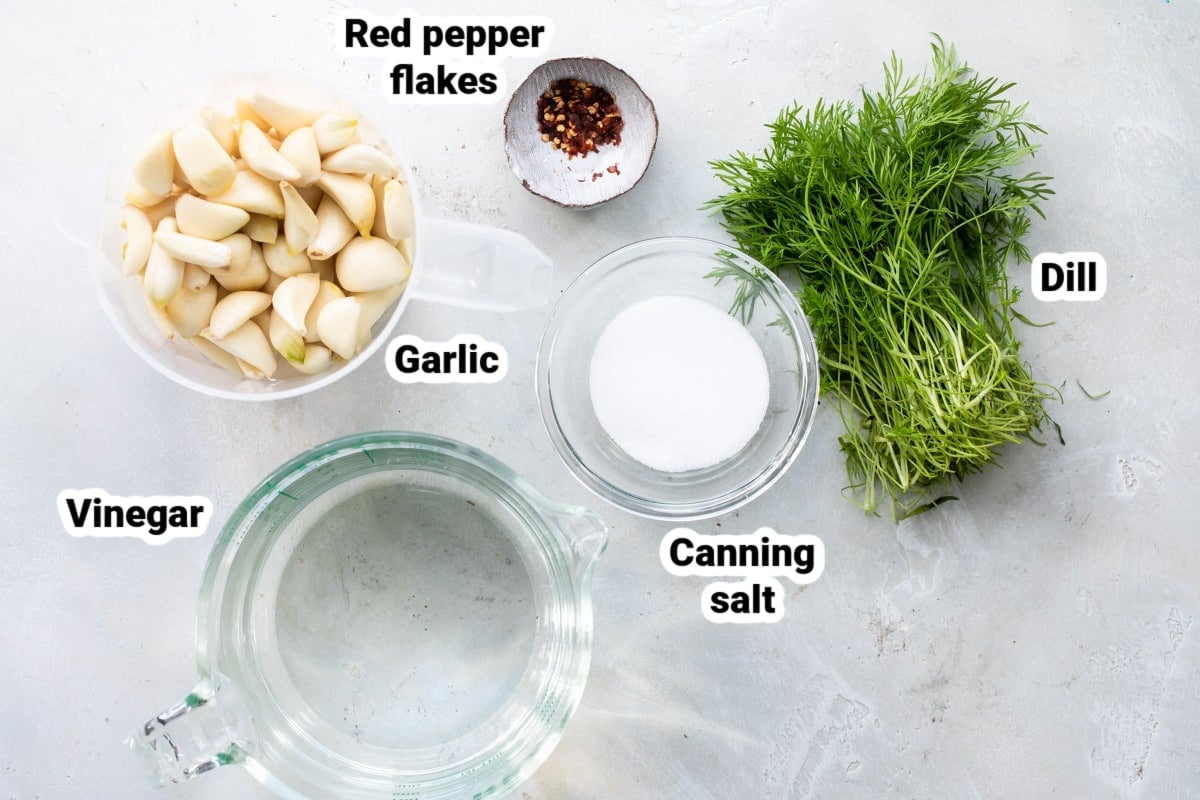
At a Glance: Here is a quick snapshot of what ingredients are in this recipe.
Please see the recipe card below for specific quantities.
Ingredient notes
- WARNING: This recipe is not suitable for shelf-stable canning. Obviously people (or companies) sell shelf-stable pickled garlic, but I am not an expert in this area and garlic has a propensity to develop botulism. So, if you make this recipe, you MUST store it in the refrigerator. Even if you seal the jars with a water bath. Refrigerate! “Canning of garlic is not recommended. Garlic is a low-acid vegetable that requires a pressure canner to be properly processed. Garlic loses most of its flavor when heated in this way. For this reason, adequate processing times have not been determined for canning garlic.”
Step-by-step instructions
- Combine canning salt and vinegar in a large saucepan. Bring to boil; reduce heat and simmer 10 minutes (180 degrees). Meanwhile, pack garlic into 4 sterilized pint jars (about 8 ounces per jar) leaving 1/2-inch of headspace. Add ¼ teaspoon red pepper flakes and 1 head of dill to each jar. (If using fresh dill, add ½ cup to each jar.)

- Using a ladle, divide hot pickling liquid between the 4 jars, leaving 1/2-inch of headspace. Remove air bubbles, clean jar rims, center lids on jars, and adjust band to fingertip-tight.
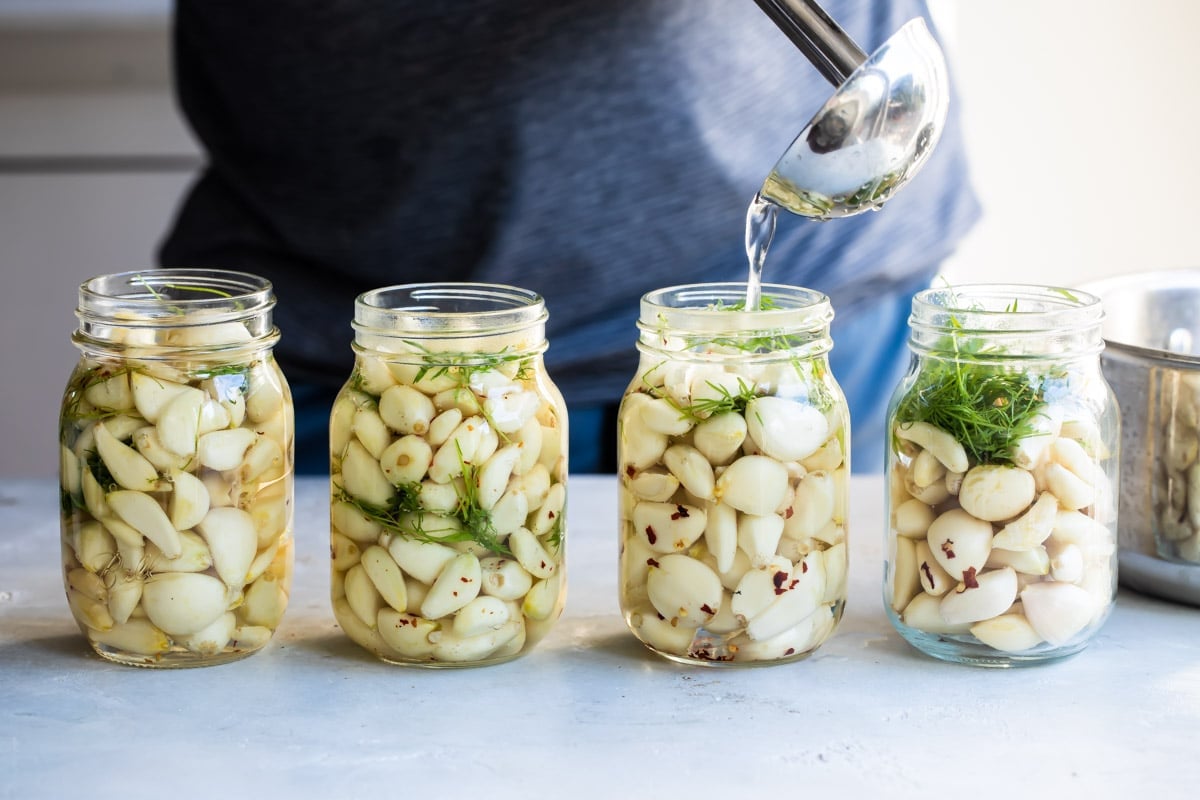
- Chill in the refrigerator until pickled as desired (I recommend at least 3 weeks in the refrigerator). Store in refrigerator for up to 4 months (see notes) or seal jars following the instructions below (the pickled garlic must still be refrigerated; it will not be shelf-stable).
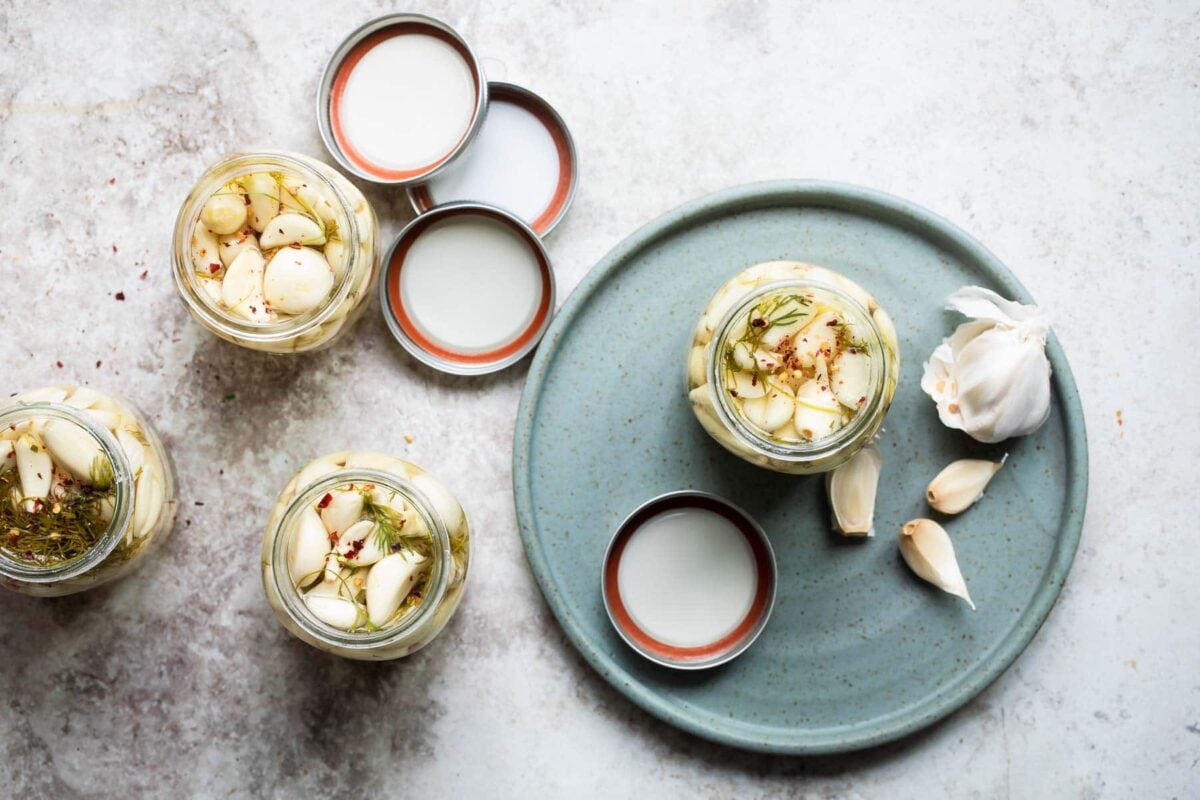
Recipe tips and variations
- Yield: This recipe makes 4 pints (8 cups), enough for 32 servings, ¼ cup each.
- Storage: The National Center for Home Food Preservation states that the garlic and vinegar mixture may be refrigerated for up to 4 months. It’s safe to use the flavored liquid for other things. Discard if you see any signs of mold or yeast growth.
- Blue garlic: Sometimes pickled garlic turns blue or turquoise when you pickle it. It’s completely normal and still safe to eat and you don’t need to worry. You can read all about the chemistry of garlic (and exactly why it may or may not turn blue). To prevent the bluish color:
- User kosher salt or sea salt to avoid iodine
- Use stainless steel or enamel cookware and utensils (avoid copper, aluminum, cast iron, and tin cookware and utensils)
- Reduce chlorophyll production by avoiding sunlight
- Use distilled water to avoid the trace minerals found in tap water
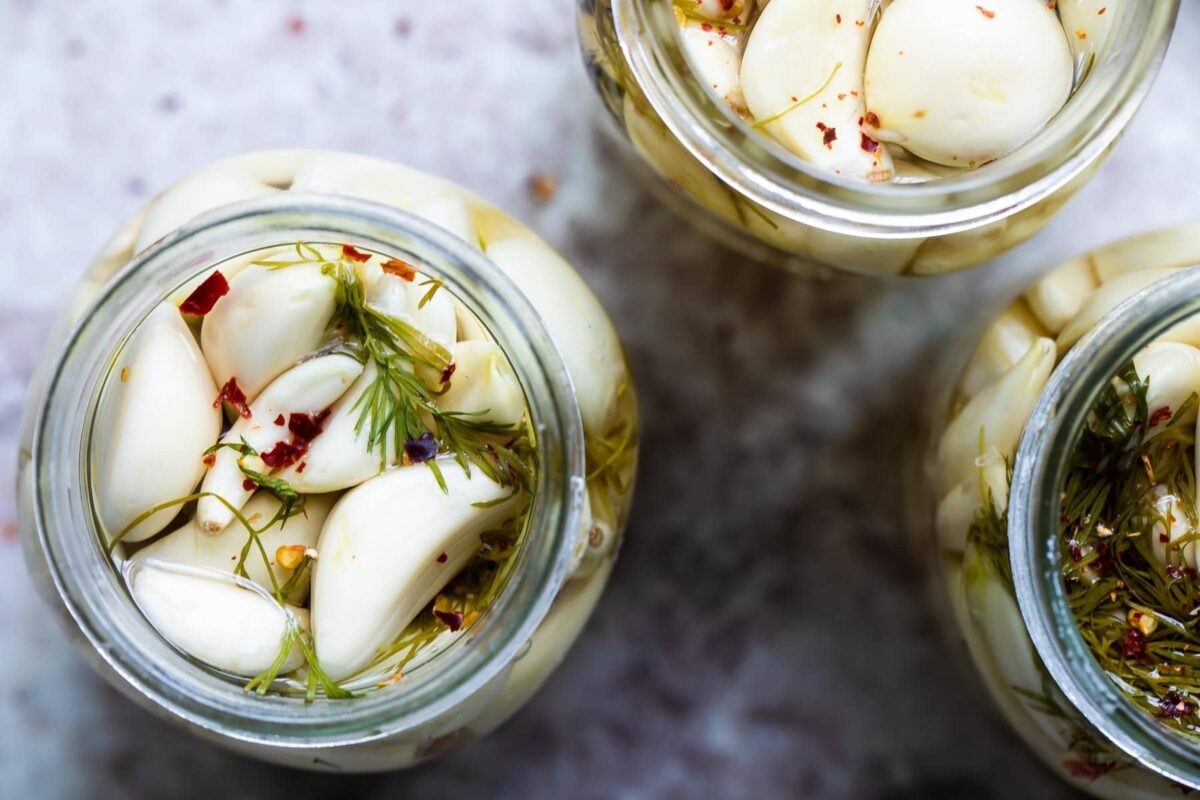
Bloody Mary Bar
Lazy weekends and holiday mornings call for a Bloody Mary Bar with homemade mix and all the savory pickled stuff you can find. It’s a total crowd-pleaser; from the purists to the meal-in-a-glass folks, everyone…
View RecipePut your pickled garlic to work
Entertaining
Midwest Charcuterie Board
Italian Recipes
Antipasto Platter
Appetizer Recipes
Jarcuterie
Appetizer Recipes
Ham Roll Ups
Join Us
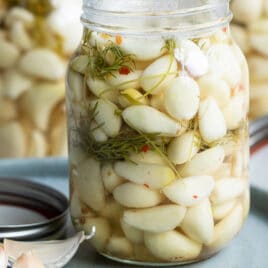
Pickled Garlic
Equipment
Ingredients
- 1/4 cup canning salt
- 5 cups white vinegar
- 2 pounds fresh garlic peeled
- 1 teaspoon red chili flakes
- 4 heads fresh dill or 2 cups fresh, stems and leaves coarsely chopped
Instructions
- Combine canning salt and vinegar in a large saucepan. Bring to boil; reduce heat and simmer 10 minutes (180 degrees).
- Meanwhile, pack garlic into 4 sterilized pint jars (about 8 ounces per jar) leaving 1/2-inch of headspace. Add ¼ teaspoon red pepper flakes and 1 head of dill to each jar. (If using fresh dill, add ½ cup to each jar.)
- Using a ladle, divide hot pickling liquid between the 4 jars, leaving 1/2-inch of headspace. Remove air bubbles, clean jar rims, center lids on jars, and adjust band to fingertip-tight.
- Chill in the refrigerator until pickled as desired (I recommend at least 3 weeks in the refrigerator). Store in refrigerator for up to 4 months (see notes) or seal jars following the instructions below (the pickled garlic must still be refrigerated; it will not be shelf-stable).
To seal jars (MUST BE REFRIGERATED, NOT SHELF-STABLE):
- Process jars in boiling water for 10 minutes. The jars must be covered by at least 1 inch of water. Turn off heat and remove cover. Let jars cool 5 minutes. Cool 12 hours. Check seals. Chill in the refrigerator until pickled as desired (I recommend at least 3 weeks in the refrigerator). Store in refrigerator for up to 4 months (see notes).
Recipe Video
Notes
- WARNING: This recipe is not suitable for shelf-stable canning. Obviously people (or companies) sell shelf-stable pickled garlic, but I am not an expert in this area and garlic has a propensity to develop botulism. So, if you make this recipe, you MUST store it in the refrigerator. Even if you seal the jars with a water bath. Refrigerate! “Canning of garlic is not recommended. Garlic is a low-acid vegetable that requires a pressure canner to be properly processed. Garlic loses most of its flavor when heated in this way. For this reason, adequate processing times have not been determined for canning garlic.”
- Yield: This recipe makes 4 pints (8 cups), enough for 32 servings, ¼ cup each.
- Storage: The National Center for Home Food Preservation states that the garlic and vinegar mixture may be refrigerated for up to 4 months. It’s safe to use the flavored liquid for other things. Discard if you see any signs of mold or yeast growth.
- Blue garlic: Sometimes pickled garlic turns blue or turquoise when you pickle it. It’s completely normal and still safe to eat and you don’t need to worry. You can read all about the chemistry of garlic (and exactly why it may or may not turn blue). To prevent the bluish color:
- User kosher salt or sea salt to avoid iodine
- Use stainless steel or enamel cookware and utensils (avoid copper, aluminum, cast iron, and tin cookware and utensils)
- Reduce chlorophyll production by avoiding sunlight
- Use distilled water to avoid the trace minerals found in tap water.
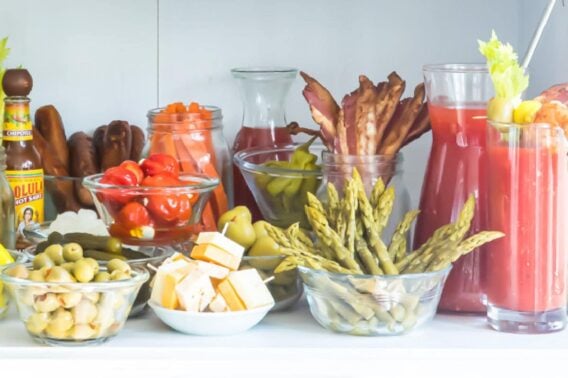

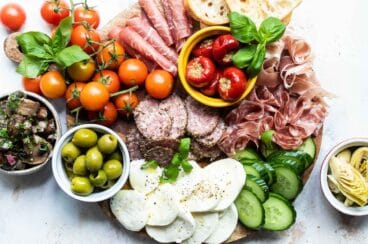
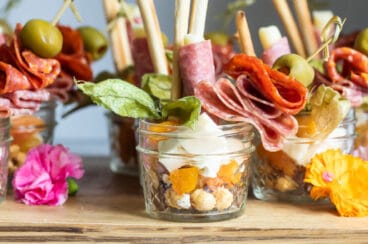
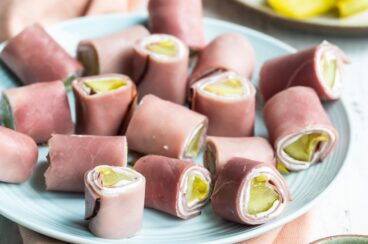
Well I went ahead and made it as you had it w/o water and it was delicious! We started eating them the next day, but we love garlic.
Super confused. Did I miss something? Says to use distilled water to preventing blue garlic, but I don’t see water in this recipe??
Hi Lisa, I’m so sorry about this!!! Up until about 2-3 weeks ago, the mixture for this pickled garlic was 1/2 vinegar, 1/2 water. But there are a lot of people who read my post and leave comments (garlic or pickling experts) and so based on their feedback and some additional research of my own, I recently swapped out the water and now it’s ALL vinegar. But I forgot to go back and fix the post to take that part out. It’s totally my fault! Garlic is just kind of a risky ingredient overall so I’d rather be safe than sorry. But yes it’s confusing since now there is no water. I will fix the post. So sorry about that! Thank you! -Meggan
Meggan-
Thank you for clarifying! I was so confused. Haha!
What we’re the reasons for not adding water?? I made my last batch with only vinegar, and it didn’t turn out like my first batch (that had water). Not sure if this would make a difference?? But the garlic didn’t pickle. It is so spicy, as if biting into a raw clove. I also didn’t do a hot water bath the second batch, and just put them in the fridge.
Thoughts?
Hi Nicole, so this is a great example of me taking advice from strangers on the internet without testing the recipe myself, ha ha! I have only ever made pickled garlic with half vinegar, half water. I’ve never made it with ALL vinegar, I only changed the recipe because strangers on the internet said I should. I was just wondering if the recipe you made was mine (the one that yielded the raw garlic cloves). I don’t think it would have been the hot water bath that was the issue. I do think, however, that I’m going to change this back to have half water, half vinegar, at LEAST until I test it with all vinegar to see what happens. Sorry for the confusion, this recipe is turning out to be all sorts of complicated. A least from a safety standpoint, as long as the garlic is ALWAYS refrigerated, I can’t think of why using half water would be a problem. Thanks. -Meggan
How soon after can this garlic be eaten? Is it safe to say the longer you let it sit, the more mellow the garlic will become?
Hi Chris, yes, the flavors of the brine develop and the flavor of the garlic mellows the longer it sits. I have eaten this as soon as the next day (how long it takes to chill to my liking) but some websites recommend you let the flavors develop for 3 weeks. So you could sample one the next day and see what you think, and let it sit longer as you see fit. Thanks! -Meggan
Just made my first batch today! How long do you recommended before eating? So excited to try them!
At least 4 months
We started eating ours a week after! This was two weeks ago- and have gone through two jars already. My kids eat it like candy! So good!
do the have to be refrigerated after there canned
Hi Ernest, for my recipe yes! I don’t have a lot of experience with canning, and there are no instructions for canning in this post (it’s just about pickling, and yes the garlic needs to refrigerated). You need to be extra careful with garlic because of the risk of botulism, so I wouldn’t even feel comfortable providing instructions on how to can garlic (pickled or otherwise) even if I knew how. So just keep this in the fridge please! Thank you! Take care. -Meggan
A player who simply gained a big jackpot, reached the processor steer, and
is moving his luck.
Hi. I’ve also just started making my own garlic pickle. I however have found I notched it up.. So it’s sweet sour garlic chili pickle.
I’ve also played around with trying to eliminate the colour change from blue to purple. What seemed to work at one time was pouring hot water.. Leaving garlic for about 2minutes then into very cold water. I then on high heat give it a quick stir fry.. Let that cool completely then add my already boiled vinagar.
Thanks for this recipe, Meggan! I’ve been on such a garlic / pickle kick that this recipe is exactly what I needed
This one is for Samantha, the recipe police “;-)
You say it’s unsafe to can garlic? I hope that’s not really the case though. I am still eating pickles from 2015 (it’s 2018) and not only are they the best damn pickles (coming from a non-pickle fan) but they contain cloves of garlic. In fact many of my pickling recipes of course came from the internet that call for cloves of garlic. Can you clarify the worst scenario her (aside from botulism)? Right now, before reading your comments here about the dangers, I’m canning 3.5 cloves of garlic in a pint jar (or whatever the tall thin jar is). The reason I came here to seek the recipe is due to some visitors I had here yesterday and the big hit in the pickles were the garlic cloves. All the jars being used around here now are from 2015 so your comment, although disconcerting for me to hear because I don’t refrigerate and haven’t for years (now that battery-gulping freezer is another story), however of course I’m going forward anyway. The recipe was altered a bit, in the freezer I found bags of dill and some onions so that’s all in the jar also pending the wood stove to bringing this pan of vinegar solution up to speed. I’m wondering if we’ve sterilized our immune system so much that we are actually making our species weaker (that’s the motif I’m rolling with at the moment so onward canned garlic!
Kenny,
As I said, I’m not the canning police, I just teach safe canning practices. I posted the link from UC Davis as to WHY garlic is not safe to can.
If you want to be nonchalant with the safety of your recipes and what you share with others, that’s up to you. Botulism is nothing to play around about. You are playing russian roulette. The granny who water bath canned her potatoes had done if for over 40 years, thought it perfectly safe. Yet, the potatoes she used for potato salad with those same canned potatos at a church picnic killed 2 people and made many very sick, herself included. I’d feel awful if one of my family or anyone else was harmed from something I’ve preserved or served.
Also, I often see all kinds of unsafe recipes (for preserving or canning) on the internet and on Facebook pages. So, just because you find recipes in the internet that has cloves of garlic in it, it doesn’t necessarily mean it’s a safe recipe.
Sterilized immune system or not, Botulism is a killer, and it’s a risk you run if you can garlic. Personally, I love pickled garlic, but I make them in small batches and refrigerate. Its a pretty quick pickle.
Good luck, I hope you and everyone you share with stays well. Sincerely.
I tried your recipe and mine turned blue. How can I make this recipe and it not turn blue ?
Hi Jim, there is actually nothing wrong or unsafe about blue pickled garlic. Sometimes that happens. I found this article which talks a lot more about it: https://www.thespruce.com/garlic-turns-blue-when-pickled-1327752
From that same article, here are some tips to prevent your garlic from turning blue (if you don’t want it to look that way). Good luck!
-Use distilled water for pickling; distilled water doesn’t have the trace metals found in a lot of tap water
-Use iodine-free salt; most kosher salt and sea salt does not have iodine
-Use stainless steel or enameled cookware and utensils; avoid copper, aluminum, cast iron and tin
-Blanch the garlic briefly (about 10 seconds or so); this may or may not prevent coloring and can affect taste, so try this judiciously
-Store fresh and pickled garlic away from sunlight, which can lead to chlorophyll formation
use distilled water